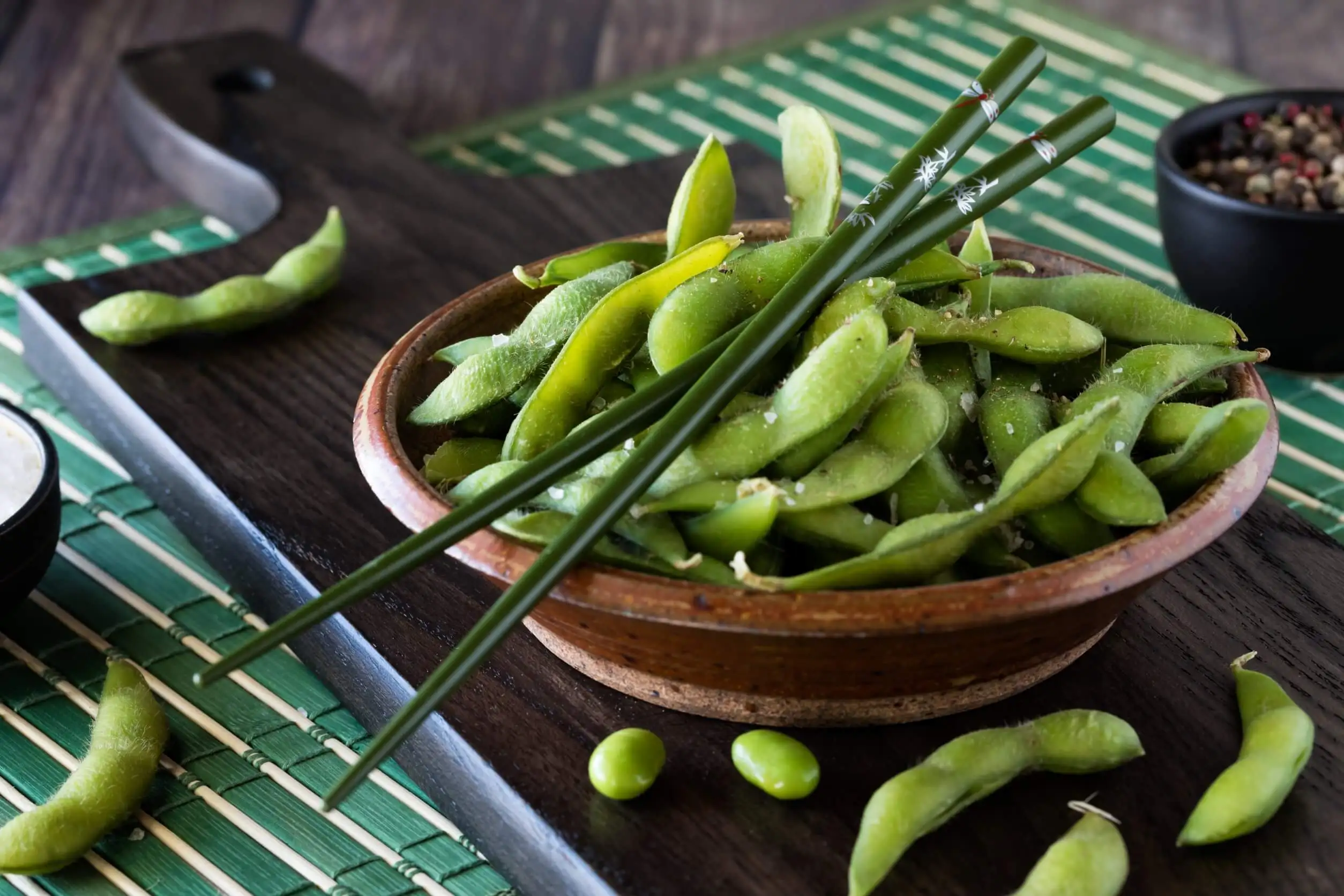The Nutritional Properties of Edamame and Recipes


Written and verified by the nutritionist Saúl Sánchez Arias
Edamame is an immature soybean that’s still in its pod and you can consume as is. Due to its nutritional composition, it comes with several health benefits. In addition, it’s easy to prepare and you can eat it as a healthy snack. Want to know more about its properties?
As detailed in an article reported in Frontiers in Plant Science, this food is common in East Asia. However, its consumption is now a trend in the United States and Europe due to the qualities people attribute to it. In the following article, we’ll take a look at how people use it.
The nutritional properties of edamame
Although edamame has been around for more than 2000 years in Asia, its only recently become popular. In countries in North America, Europe and Africa, it’s known as a vegetable source of protein, isoflavones, vitamins and minerals.
According to information compiled by the United States Department of Agriculture (USDA), each 155-gram serving of edamame provides the following:
- Calories: 188
- Fat: 8 grams
- Sodium: 9.4 milligrams
- Carbohydrates: 13.8 grams
- Fiber: 8 grams
- Sugars: 3.4 grams
- Protein: 18.4 grams
Farmers harvest edamame when the soybean pods are full, but the beans are still green and at a high moisture level. This is its main difference from soybeans, which people harvest when the pods and beans are already completely dry.
Protein
Note that edamame is a significant source of protein. One cup can provide about 18.4 grams. The most interesting thing? It’s high quality. According to a publication in the Journal of the Science of Food and Agriculture, it has a well-balanced amino acid profile.
Because of the above, it’s one of the best sources of vegetable protein. It’s ideal for improving the quality of vegan and vegetarian diets. Estimates indicate that one third of its total calories come from this nutrient.
Carbohydrates
Edamame has carbohydrates inside, but almost all of them are of the complex type. It’s possible to find 10 grams of these elements per 100 grams of product.
However, it also provides a high amount of fiber; therefore, there is a slower absorption of the few sugars that it concentrates and generates a lower impact at pancreatic level.
Fats
From the point of view of lipids, it should be noted that most of the fatty acids in edamame are of the polyunsaturated type. The truth is that it only contains 5 grams of fat per 100 of product, so this is hardly any fat. In addition, it doesn’t have a high concentration of calories.
Micronutrients
In the micronutrients section, the food’s iron, calcium, magnesium and vitamin C content should be highlighted. However, it should be noted that the large amount of fiber it provides may reduce the bioavailability of some of these elements.
The health benefits of edamame
Due to its particular nutritional composition and specially its abundant protein content, edamame is associated with several health benefits. Let’s take a look.
Efficient intestinal transit

The contribution of edamame fiber is important to ensure optimal intestinal transit. This substance manages to increase the volume of the fecal bolus and helps to have more intense peristaltic contractions. Therefore, it’s a good option to reduce your risk of constipation.
For now, there are no studies that concretely prove that edamame helps to relieve constipation. Still, as an abundant source of dietary fiber, it’s a recommended food for patients with this problem.
Cardiovascular health
Edamame is one of the soy derivatives whose intake is linked to better cardiovascular health. In a meta-analysis shared by the Journal of the American Heart Association, it was determined that the intake of soy and its derivatives collaborates in the reduction of bad cholesterol (LDL) and total cholesterol.
Meanwhile, through Complementary Therapies in Medicine, it was reported that soy intake has a favorable effect in lowering blood pressure. Therefore, the intake of foods such as edamame is ideal for reducing the risks of cardiovascular diseases.
Increased bone density
Including soy protein in your diet may contribute to the prevention of bone diseases. In a study shared by the Journal of Medicinal Food, researchers determined that soy isoflavones help prevent the loss of bone density that can lead to osteoporosis, especially in stages such as menopause.
The effect of edamame on bone health has not yet been specifically analyzed. Despite this, its inclusion in the diet is beneficial for maintaining healthy and strong bones. However, it’s also important to consider other measures, such as optimal calcium intake and physical exercise.
Other possible health benefits of edamame
Although research on edamame is still scarce, some clinical evidence suggests that it may have other health benefits, such as the following:
- Decreased menopausal symptoms, especially hot flashes. This is due to its isoflavone content.
- Antitumor potential. Medical studies show that the rate of breast and prostate cancer is lower in countries with a higher consumption of soy and its derivatives. The hypothesis is that isoflavones have chemo-preventive effects. However, we need more extensive and conclusive studies.
How to prepare edamame

You can eat edamame dry as a snack like many other nuts. However, it’s also possible to find it frozen, so it will require a previous cooking process. Therefore, we are going to show you two simple recipes to prepare it.
Dressed edamame
To make this dish it’s best to buy natural or frozen edamame. Then, boil with water and salt for 5 minutes, starting a boil.
Once the pods are ready, arrange them in a bowl and prepare a dressing with soy sauce, the juice of half a lemon and some sesame seeds. Pour the mixture on top and serve.
Red edamame
In this case the edamame gets a fash if sweet paprika to vary its color and the final result. Start by boiling the product in water for 4 or 5 minutes,l until it softens slightly. Do all of this in salted water.
Once the pods are ready, you cool them in a container with water, where you’ll mix it with sweet paprika and salt. In this way, you can eat it as a snack or starter, as it’s still crunchy.
Adverse effects of edamame
Like other varieties of legumes, edamame can cause flatulence and abdominal bloating after consumption. To avoid this, cook it longer. It’s also advisable to reduce the portion eaten if this is your problem.
Introduce edamame into your regular diet
Edamame is a healthy food you can include in a balanced diet. It has essential nutrients for the proper functioning of the body, such as protein, dietary fiber and fatty acids.
In addition, it’s increasingly common to find it in supermarkets ready to eat. Even so, its homemade preparation is very simple. It only requires a short cooking process and a seasoning that improves the final result in terms of flavor. So, are you going to try it?
All cited sources were thoroughly reviewed by our team to ensure their quality, reliability, currency, and validity. The bibliography of this article was considered reliable and of academic or scientific accuracy.
- Dhakal K, Zhu Q, Zhang B, Li M, Li S. Analysis of Shoot Architecture Traits in Edamame Reveals Potential Strategies to Improve Harvest Efficiency. Front Plant Sci. 2021 Mar 3;12:614926. doi: 10.3389/fpls.2021.614926. PMID: 33746998; PMCID: PMC7965963.
-
Jenkins, D. J. A., Blanco Mejia, S., Chiavaroli, L., Viguiliouk, E., Li, S. S., Kendall, C. W. C., Vuksan, V., & Sievenpiper, J. L. (2019). Cumulative Meta‐Analysis of the Soy Effect Over Time. In Journal of the American Heart Association (Vol. 8, Issue 13). Ovid Technologies (Wolters Kluwer Health). https://doi.org/10.1161/jaha.119.012458
-
Jiang GL, Katuuramu DN. Comparison of seed fatty and amino acids in edamame dried using two oven-drying methods and mature soybeans. J Sci Food Agric. 2021 Mar 15;101(4):1515-1522. doi: 10.1002/jsfa.10766. Epub 2020 Sep 21. PMID: 32851665.
-
Messina, M. (2016). Soy and Health Update: Evaluation of the Clinical and Epidemiologic Literature. In Nutrients (Vol. 8, Issue 12, p. 754). MDPI AG. https://doi.org/10.3390/nu8120754
-
Messina M. Soybean Isoflavones Warrant Greater Consideration as a Treatment for the Alleviation of Menopausal Hot Flashes. Women’s Health. 2014;10(6):549-553. doi:10.2217/WHE.14.38
-
Mosallanezhad, Z., Mahmoodi, M., Ranjbar, S., Hosseini, R., Clark, C. C. T., Carson-Chahhoud, K., Norouzi, Z., Abbasian, A., Sohrabi, Z., & Jalali, M. (2021). Soy intake is associated with lowering blood pressure in adults: A systematic review and meta-analysis of randomized double-blind placebo-controlled trials. In Complementary Therapies in Medicine (Vol. 59, p. 102692). Elsevier BV. https://doi.org/10.1016/j.ctim.2021.102692
-
Williams MM 2nd, Zhang B, Fu X, Ross J. Editorial: Everything edamame: Biology, production, nutrition, sensory and economics. Front Plant Sci. 2022 Jul 27;13:976008. doi: 10.3389/fpls.2022.976008. PMID: 35968089; PMCID: PMC9363820.
-
Yang J, Wang HP, Zhou L, Xu CF. Effect of dietary fiber on constipation: a meta analysis. World J Gastroenterol. 2012 Dec 28;18(48):7378-83. doi: 10.3748/wjg.v18.i48.7378. PMID: 23326148; PMCID: PMC3544045.
-
Zheng, X., Lee, S.-K., & Chun, O. K. (2016). Soy Isoflavones and Osteoporotic Bone Loss: A Review with an Emphasis on Modulation of Bone Remodeling. In Journal of Medicinal Food (Vol. 19, Issue 1, pp. 1–14). Mary Ann Liebert Inc. https://doi.org/10.1089/jmf.2015.0045
This text is provided for informational purposes only and does not replace consultation with a professional. If in doubt, consult your specialist.








